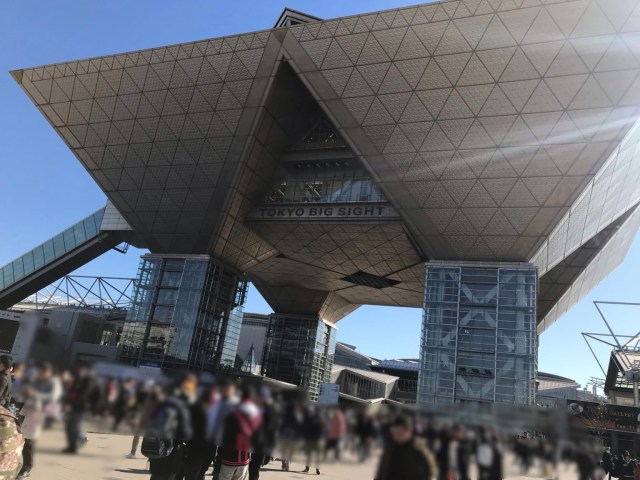
Some fear the tradition may never return, but most just hope so.
Shortly after sunrise on 13 August, a lone man dressed in yellow stood outside of the entrance to Kokusai-Tenjijo Station. Though nervous about what was to come, he stood strong and with confidence that he could handle the job assigned to him.
That job was to corral hundreds of stampeding otaku, hungry for independently produced content, in what has become known as Comiket Dash. This biannual mass migration of otaku is a beautiful natural phenomenon in which otaku flood as fast as they can from the first train of the day to the entrance of the Tokyo Big Sight convention center, which Kokusai-Tenjijo Station is the closest stop to.
However, this time the flood was a mere trickle…
りんかい線の始発が国際展示場駅に到着。
— おんさ🙏🍁🍵👾𝓟𝓟𝓔 (@onsa2235) August 12, 2022
チケット制になったため、かつてのようなダッシュはありません。
#C100 pic.twitter.com/vNaPVoPZrD
This is the second time that the Comiket Dash has failed to materialize. Instead of running through ticket gates with reckless abandon, the otaku appeared far more placid and orderly. For comparison here’s footage of a Comiket Dash from 2018.
When this scene didn’t unfold last winter, many pointed at the pandemic as the cause. The independent comic, cosplay, and video game convention was canceled three times due to COVID-19 and even last December it was on shaky ground, being held with attendance limits and fears that the plug could be pulled if things got out of hand.
However, this summer, despite the record number of infection cases, event restrictions in Japan are becoming increasingly relaxed, so a good old-fashioned Comiket Dash probably wouldn’t have been an issue anymore. Some suggested another possible cause was that a typhoon was on a collision course with the area on the day of the event which might have encouraged to keep everyone on their best behavior.
▼ Many attendees were battered with rain and wind while waiting patiently to enter the venue
But the most likely reason that the Dash was dashed has to do with changes to the admission system. The number of attendees was limited to between 80,000 and 90,000 this time, but more importantly tickets were sold in advance. When purchasing a ticket, attendees are given a scheduled check-in time window to intentionally spread out the number of people entering at one time.
▼ It’s an event planning technique known as “the Moe Howard.”
Since numbers are limited and entry is staggered, the incentive to run like mad has been greatly diminished and people are once again free to stop and ask for directions without fear of being trampled, as seen in this video.
穏やかな始発ダッシュとなりました #C100 pic.twitter.com/b5Rt5rtUea
— うわず (@uwaz_uzuz) August 12, 2022
Comments regarding this development seem happy with the change of pace and hope it becomes the norm.
“I think they didn’t want to do a ticket system like this before because they didn’t think of themselves as a major commercial event, but I think we can see it’s a good idea.”
“Wow, add the Dash to things erased by COVID-19.”
“I looks like any other day except no one’s wearing a suit.”
“The organizers probably lost a lot of money from the pandemic, so this is also a good way to keep security costs down.”
“I don’t know why they didn’t do this sooner.”
“But I think that was the only time a lot of these guys exercised.”
“I still think it’ll take just one person to start running and then start a chain reaction.”
There does seem to be a tipping point that would trigger a Dash relapse if numbers continue to get big enough. However, as one comment alluded to, Comiket should probably stop pretending like it’s still some intimate indie gathering and start acting like the major event it has become. Curbing the mad dash that ensues every time would be a good first step, preferably followed by stopping sweat clouds from forming.
Source: Hachima Kiko, Facebook/ComicMarket
Top image: © SoraNews24
● Want to hear about SoraNews24’s latest articles as soon as they’re published? Follow us on Facebook and Twitter!

 Biannual Comiket otaku migration attracts a predator for the first time 【Video】
Biannual Comiket otaku migration attracts a predator for the first time 【Video】 Recent opening dash of 2018 Winter Comiket the last in the Heisei era, new race tactic observed
Recent opening dash of 2018 Winter Comiket the last in the Heisei era, new race tactic observed Time-lapse video shows the awesomely orderly efficiency of otaku lining up at Comiket【Video】
Time-lapse video shows the awesomely orderly efficiency of otaku lining up at Comiket【Video】 Comiket returns! Japan’s largest otaku convention announced for 2021 with new admission policies
Comiket returns! Japan’s largest otaku convention announced for 2021 with new admission policies The beautiful cosplayers of summer Comiket 2018【Photos】
The beautiful cosplayers of summer Comiket 2018【Photos】 Foreigner’s request for help in Tokyo makes us sad for the state of society
Foreigner’s request for help in Tokyo makes us sad for the state of society Seaside scenery, history, and so many desserts on Yokohama’s Akai Kutsu【Japan Loop Buses】
Seaside scenery, history, and so many desserts on Yokohama’s Akai Kutsu【Japan Loop Buses】 Japanese city loses residents’ personal data, which was on paper being transported on a windy day
Japanese city loses residents’ personal data, which was on paper being transported on a windy day Smash Bros. director Sakurai stabs Kirby in the face, has delicious justification for it
Smash Bros. director Sakurai stabs Kirby in the face, has delicious justification for it Red light district sushi restaurant in Tokyo shows us just how wrong we were about it
Red light district sushi restaurant in Tokyo shows us just how wrong we were about it Japanese ramen restaurants under pressure from new yen banknotes
Japanese ramen restaurants under pressure from new yen banknotes Historical figures get manga makeovers from artists of Spy x Family, My Hero Academia and more
Historical figures get manga makeovers from artists of Spy x Family, My Hero Academia and more Japan’s summertime towelket pillowcases are even better with the addition of Ghibli stars【Photos】
Japan’s summertime towelket pillowcases are even better with the addition of Ghibli stars【Photos】 Hyogo town scares children away with mechanical kappa in park’s pond
Hyogo town scares children away with mechanical kappa in park’s pond 10 crazy pizzas from Japan
10 crazy pizzas from Japan McDonald’s new Happy Meals offer up cute and practical Sanrio lifestyle goods
McDonald’s new Happy Meals offer up cute and practical Sanrio lifestyle goods French Fries Bread in Tokyo’s Shibuya becomes a hit on social media
French Fries Bread in Tokyo’s Shibuya becomes a hit on social media Studio Ghibli releases new action figures featuring Nausicaä of the Valley of the Wind characters
Studio Ghibli releases new action figures featuring Nausicaä of the Valley of the Wind characters New private rooms on Tokaido Shinkansen change the way we travel from Tokyo to Kyoto
New private rooms on Tokaido Shinkansen change the way we travel from Tokyo to Kyoto Tokyo Tsukiji fish market site to be redeveloped with 50,000-seat stadium, hotel, shopping center
Tokyo Tsukiji fish market site to be redeveloped with 50,000-seat stadium, hotel, shopping center Beautiful Ghibli sealing wax kits let you create accessories and elegant letter decorations【Pics】
Beautiful Ghibli sealing wax kits let you create accessories and elegant letter decorations【Pics】 Studio Ghibli releases Kiki’s Delivery Service chocolate cake pouches in Japan
Studio Ghibli releases Kiki’s Delivery Service chocolate cake pouches in Japan New definition of “Japanese whiskey” goes into effect to prevent fakes from fooling overseas buyers
New definition of “Japanese whiskey” goes into effect to prevent fakes from fooling overseas buyers Our Japanese reporter visits Costco in the U.S., finds super American and very Japanese things
Our Japanese reporter visits Costco in the U.S., finds super American and very Japanese things All-you-can-drink Starbucks and amazing views part of Tokyo’s new 170 meter-high sky lounge
All-you-can-drink Starbucks and amazing views part of Tokyo’s new 170 meter-high sky lounge More foreign tourists than ever before in history visited Japan last month
More foreign tourists than ever before in history visited Japan last month New Pokémon cakes let you eat your way through Pikachu and all the Eevee evolutions
New Pokémon cakes let you eat your way through Pikachu and all the Eevee evolutions Disney princesses get official manga makeovers for Manga Princess Cafe opening in Tokyo
Disney princesses get official manga makeovers for Manga Princess Cafe opening in Tokyo Sales of Japan’s most convenient train ticket/shopping payment cards suspended indefinitely
Sales of Japan’s most convenient train ticket/shopping payment cards suspended indefinitely Sold-out Studio Ghibli desktop humidifiers are back so Totoro can help you through the dry season
Sold-out Studio Ghibli desktop humidifiers are back so Totoro can help you through the dry season Japanese government to make first change to romanization spelling rules since the 1950s
Japanese government to make first change to romanization spelling rules since the 1950s Ghibli founders Toshio Suzuki and Hayao Miyazaki contribute to Japanese whisky Totoro label design
Ghibli founders Toshio Suzuki and Hayao Miyazaki contribute to Japanese whisky Totoro label design Doraemon found buried at sea as scene from 1993 anime becomes real life【Photos】
Doraemon found buried at sea as scene from 1993 anime becomes real life【Photos】 Tokyo’s most famous Starbucks is closed
Tokyo’s most famous Starbucks is closed One Piece characters’ nationalities revealed, but fans have mixed opinions
One Piece characters’ nationalities revealed, but fans have mixed opinions We asked a Uniqlo employee what four things we should buy and their suggestions didn’t disappoint
We asked a Uniqlo employee what four things we should buy and their suggestions didn’t disappoint Princesses, fruits, and blacksmiths: Study reveals the 30 most unusual family names in Japan
Princesses, fruits, and blacksmiths: Study reveals the 30 most unusual family names in Japan Comiket will require proof of coronavirus vaccination or PCR test results for admission
Comiket will require proof of coronavirus vaccination or PCR test results for admission Tokyo train station and convenience store roll out otaku welcome for Comiket attendees 【Photos】
Tokyo train station and convenience store roll out otaku welcome for Comiket attendees 【Photos】 Blast from the past: cosplayer’s retro otaku outfit hits nostalgic notes with netizens
Blast from the past: cosplayer’s retro otaku outfit hits nostalgic notes with netizens The Comiket Cloud: Anime convention’s attendees reportedly creating weather
The Comiket Cloud: Anime convention’s attendees reportedly creating weather Return of Comiket doujinshi manga convention announced for 2021 in Tokyo
Return of Comiket doujinshi manga convention announced for 2021 in Tokyo Otaku crowd control could be changing with new “anime character voice” megaphones
Otaku crowd control could be changing with new “anime character voice” megaphones Free anti-embarrassment bags to be handed out at Comiket
Free anti-embarrassment bags to be handed out at Comiket The best Japanese cosplayers from Day 4 of Summer Comiket 2019【Photos】
The best Japanese cosplayers from Day 4 of Summer Comiket 2019【Photos】 Beautiful booth models and tasty chow – A non-car guide to the Tokyo Motor Show【Photos】
Beautiful booth models and tasty chow – A non-car guide to the Tokyo Motor Show【Photos】 Station and Lawson convenience store near Tokyo Big Sight gear up for a blazing Summer Comiket
Station and Lawson convenience store near Tokyo Big Sight gear up for a blazing Summer Comiket Otaku Lovers: Japan’s new singles event that’s just for hardcore anime and video game fans
Otaku Lovers: Japan’s new singles event that’s just for hardcore anime and video game fans Summer Comiket is sizzling hot this year, and it’s not because of the weather 【Pics】
Summer Comiket is sizzling hot this year, and it’s not because of the weather 【Pics】 Comiket for beginners: 7 tips for surviving Summer Comic Market
Comiket for beginners: 7 tips for surviving Summer Comic Market Heading to Comiket this year? Be sure to donate blood for a special gift!
Heading to Comiket this year? Be sure to donate blood for a special gift!
Leave a Reply